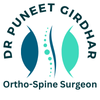What exactly is What Is A Degenerative Disc Disease (DDD)?
When discs lose water content due to disease or aging, they lose height, bringing the vertebrae closer together. As a result, your spine’s nerve openings become narrower. When this occurs, the discs do not absorb shocks as well, especially when walking, running, or jumping.
Wear and tear, poor posture, and incorrect body movements can all weaken the disc and lead to disc degeneration.
What Is the Cause of Degenerative Disc Disease?
Degenerative disc disease can cause back and/or leg pain, as well as functional issues like tingling or numbness in your legs or buttocks, as well as difficulty walking.
What Are the Signs and Symptoms?
Degenerative disc disease can cause back or leg pain, as well as functional issues like tingling or numbness in your legs or buttocks, as well as difficulty walking.
How is it identified?
Degenerative disc disease is diagnosed through a physical examination of the body, with particular attention paid to the back and lower extremities. Your doctor will examine your back for flexibility, range of motion, and specific signs indicating that degenerative back changes are affecting your nerve roots. This frequently entails testing the strength of your muscles and reflexes to ensure they still function.
You will frequently be asked to fill out a diagram indicating the location of your pain, numbness, tingling, and weakness. X-rays and magnetic resonance imaging (MRI) may be recommended.
What Is The Treatment For Degenerative Disc Disease?
Treatment options vary depending on the severity of your symptoms and how much they interfere with your daily activities. Depending on your level of pain, you may want to discuss the following treatments with your doctor:
- Non-surgical treatments:- Not all patients with degenerative disc disease need surgery. Medication, physical therapy, and chiropractic care are some of the more conservative treatment options for mild to moderate pain.
- Spinal fusion:– A spinal fusion procedure can treat degenerative disc disease surgically.
